
The government's site on fermilab, a huge physics research lab institution.

The government's site on fermilab, a huge physics research lab institution.

In this video segment from Cyberchase, through addition and regrouping in base sixty, Matt helps Digit figure out what time his CyberSoufflŰ__ŰÖ will be done.

In this video segment from Cyberchase, Harry decides to train as a firefighter and uses line graphs to chart his physical fitness progress.
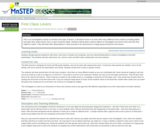
This activity is an investigative introduction to class 1 levers. Students create levers and record observations to determine the use and components of a lever.
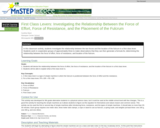
This is an exploratory activity where students in small groups discover the relationship between the force of resistance, the force of effort, and placement of the fulcrum in a first class lever.
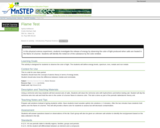
This activity is an observation lab where students observe the colors emitted by various metal ions in salt solutions.
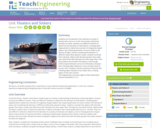
Students are introduced to the important concept of density with a focus is on the more easily understood densities of solids. Students use different methods to determine the densities of solid objects, including water displacement to determine volumes of irregularly-shaped objects. By comparing densities of various solids to the density of water, and by considering the behavior of different solids when placed in water, students conclude that ordinarily, objects with densities greater than water sink, while those with densities less than water float. Then they explore the principle of buoyancy, and through further experimentation arrive at Archimedes' principle that a floating object displaces a mass of water equal to its own mass. Students may be surprised to discover that a floating object displaces more water than a sinking object of the same volume.
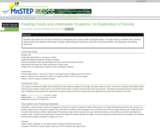
This is a classroom lab where students will explore the concept of density by investigating how various solids and liquids interact.
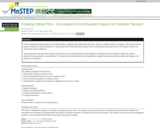
This activity is a guided inquiry on surface tension where students design their own lab experiment based on a focus question, make predictions, collect data and compare the outcome with their predictions.

Students discover fluid dynamics related to buoyancy through experimentation and optional photography. Using one set of fluids, they make light fluids rise through denser fluids. Using another set, they make dense fluids sink through a lighter fluid. In both cases, they see and record beautiful fluid motion. Activities are also suitable as class demonstrations. The natural beauty of fluid flow opens the door to seeing the beauty of physics in general.

In this video segment adapted from NOVA, scientists investigate how farming along the Mississippi River impacts floods and what can be done about it.
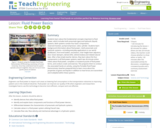
Students learn about the fundamental concepts important to fluid power, which includes both pneumatic (gas) and hydraulic (liquid) systems. Both systems contain four basic components: reservoir/receiver, pump/compressor, valve, cylinder. Students learn background information about fluid power—both pneumatic and hydraulic systems—including everyday applications in our world (bulldozers, front-end loaders, excavators, chair height lever adjustors, door closer dampers, dental drills, vehicle brakes) and related natural laws. After a few simple teacher demos, they learn about the four components in all fluid power systems, watch two 26-minute online videos about fluid power, complete a crossword puzzle of fluid power terms, and conduct a task card exercise. This prepares them to conduct the associated hands-on activity, using the Portable Fluid Power Demonstrator (teacher-prepared kits) to learn more about the properties of gases and liquids in addition to how forces are transmitted and multiplied within these systems.
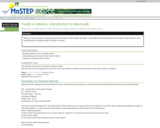
This is an in-class activity that helps introduce the idea of Bernoulli's Principle and fluid of motion. Based on original activity from Adrienne Evans.

This activity is a guided inquiry activity where students take simple measurements and use unit analysis to determine the thickness of a sheet of aluminum foil, the volume of an aluminum atom, and the radius of an aluminum atom.
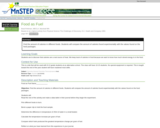
This is a lab activity to determine the amount of calories in different foods.
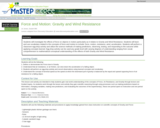
The egg-drop activity is designed to help students develop a deeper understanding of the force created by wind resistance and how it interacts with the force due to Gravity. Students will note how surface area affects the resistance of a falling object as Gravity works on it. Students will record and share observations and questions regarding the experiment.
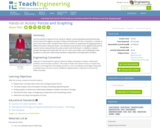
Use this activity to explore forces acting on objects, practice graphing experimental data, and introduce the algebra concepts of slope and intercept of a line. A wooden 2 x 4 beam is set on top of two scales. Students learn how to conduct an experiment by applying loads at different locations along the beam, recording the exact position of the applied load and the reaction forces measured by the scales at each end of the beam. In addition, students analyze the experiment data with the use of a chart and a table, and model/graph linear equations to describe relationships between independent and dependent variables.

In this lesson designed to enhance literacy skills, students learn how the forces of gravity and air resistance affect the motion of falling objects.
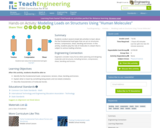
Students conduct several simple lab activities to learn about the five fundamental load types that can act on structures: tension, compression, shear, bending and torsion. In this activity, students play the role of molecules in a beam that is subject to various loading schemes.

This media-rich essay from NOVA Online describes the challenges of forecasting volcanic eruptions and includes information about specific cases.